2013中国机器人大赛RoboCup标准平台组(2v2)(4v4)比赛规则
- 格式:pdf
- 大小:1.31 MB
- 文档页数:29
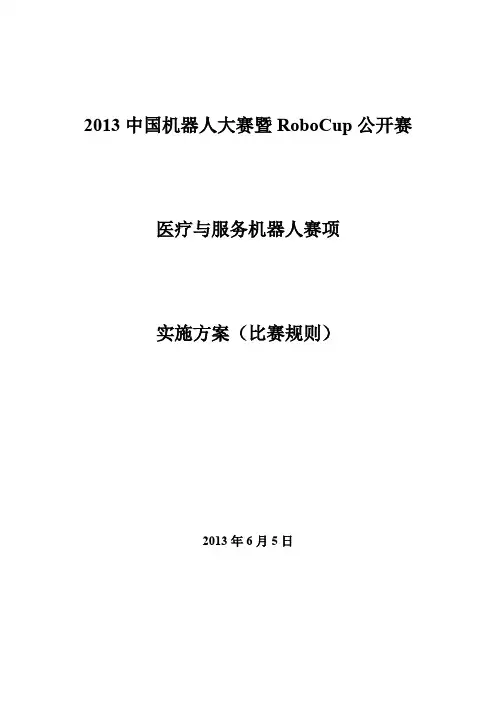
2013中国机器人大赛暨RoboCup公开赛医疗与服务机器人赛项实施方案(比赛规则)2013年6月5日一.概述机器人向实际应用方向发展有其重要的现实意义,研发面向实际应用的机器人有长远的价值。
医疗与服务机器人赛项正是引导机器人向实际应用方向发展的重要切入点。
2013年中国机器人大赛暨RoboCup公开赛医疗与服务机器人赛项的比赛规则调整如下。
1.实施本项目具有长远的战略意义机器人要真正“实用”是极其艰难的,尤其是“医用”更是难乎其难,需要大批拔尖创新人才、高技能人才为之长期攻关和付出。
因此实施本项目具有长远的战略意义。
在上海举办的举世瞩目的世博会上,欧洲馆的主题是:“智能欧洲。
”可见世界发达国家已把机器人的研究方向定位到开发成智能化的产品。
在这种国际背景下中国机器人大赛暨RoboCup公开赛组委会审时度势把医疗与服务机器人设立为赛项,旨在引领我国有识之士投身到医疗与服务机器人的研发与竞赛中来。
2.实施本项目是当务之急虽然机器人的实际应用尤其是医用不是一蹴而就的,但不能阻挡我们只争朝夕地研发和向实际应用方向前进的脚步。
在产品向智能化方向发展的大环境下,我国大学生已进行了多届机器人大赛,有了良好的基础。
引领参赛选手向机器人实际应用方向发展已是水到渠成。
我国目前每年要进口数以千亿元计的医疗器械,尤其是昂贵的医疗手术机器人(进口的达芬奇手术机器人每台的价格高达2千多万元)。
因此引领我国大学生参加医疗与服务机器人竞赛,尤其是引领他们创新设计研制医疗与服务机器人已经成为当务之急。
3.实施本项目的可操作性基于上述分析,大赛组委会决定设“医疗与服务机器人组”,希望通过此项目比赛增强选手的实际应用能力,尤其是增强选手普遍关注的在高科技领域就业的竞争能力。
本赛项为选手提供广阔的施展才华的舞台,同时也让选手有章可循。
技术委员会既考虑项目的实用性、先进性、新颖性,更考虑到项目的可参与性和可操作性以及在经济上的可承受性,也就是着重考虑使项目适合竞赛,符合学校实际、学生实际,因此特决定把竞赛分为独立的两个子赛项:1)医疗与服务机器人规定动作赛项,本赛项兼设青少年组;2)医疗与服务机器人创新设计与制作赛项,本赛项兼设青少年组和教师发明组。
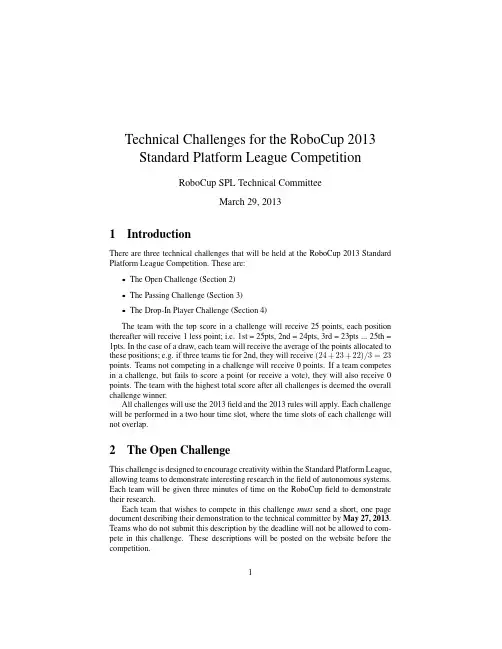
Technical Challenges for the RoboCup2013Standard Platform League CompetitionRoboCup SPL Technical CommitteeMarch29,20131IntroductionThere are three technical challenges that will be held at the RoboCup2013Standard Platform League Competition.These are:•The Open Challenge(Section2)•The Passing Challenge(Section3)•The Drop-In Player Challenge(Section4)The team with the top score in a challenge will receive25points,each position thereafter will receive1less point;i.e.1st=25pts,2nd=24pts,3rd=23pts...25th= 1pts.In the case of a draw,each team will receive the average of the points allocated to these positions;e.g.if three teams tie for2nd,they will receive(24+23+22)/3=23 points.Teams not competing in a challenge will receive0points.If a team competes in a challenge,but fails to score a point(or receive a vote),they will also receive0 points.The team with the highest total score after all challenges is deemed the overall challenge winner.All challenges will use the2013field and the2013rules will apply.Each challenge will be performed in a two hour time slot,where the time slots of each challenge will not overlap.2The Open ChallengeThis challenge is designed to encourage creativity within the Standard Platform League, allowing teams to demonstrate interesting research in thefield of autonomous systems. Each team will be given three minutes of time on the RoboCupfield to demonstrate their research.Each team that wishes to compete in this challenge must send a short,one page document describing their demonstration to the technical committee by May27,2013. Teams who do not submit this description by the deadline will not be allowed to com-pete in this challenge.These descriptions will be posted on the website before the competition.1The winner will be decided by a vote among all the SPL teams.In particular:•The demonstration should be strongly related to the scope of the league.Ir-relevant demonstrations,such as dancing and debugging tool presentations,are discouraged.•Each team may use any number of Aldebaran NAO robots.Teams must arrange for their own robots.•Teams have three minutes to demonstrate their research.At most one additional minute may be used for initial setup.Any demonstration deemed likely to require excessive time may be disallowed by the technical committee.•Teams may use extra objects on thefield as part of their demonstration.Robots other than the NAOs may not be used.•The demonstration must not mark or damage thefield.Any demonstration deemed likely to mark or damage thefield may be disallowed by the technical committee.•The demonstration may not modify the NAO robots.•The demonstration may use off-board sensors or actuators,as long as the NAO is still the focus of the challenge.This is the only challenge in which off-board sensors or actuators are allowed.•The demonstration may use off-board computing power connected over the wire-less LAN.This is the only challenge in which off-board computation is allowed.•The demonstration may use off-board human-computer interfaces.This is the only challenge in which off-board interfaces,apart from the Game Controller, are allowed.The winner will be decided by a vote among the SPL teams using a Borda count (/wiki/Borda_count).Each SPL team will vote for their top10teams in order(excluding themselves).Teams are encouraged to eval-uate the performance based on the following criteria:technical strength,novelty,ex-pected impact and relevance to RoboCup.At a time decided by the designated ref-eree,within one hour of the last demonstration if not otherwise specified,the captain of each team will submit his or her team’s rankings byfilling out an online form at http://goo.gl/vIVTr.Any points awarded by a team to itself will be disre-garded.The points awarded by the teams will be summed,and the team with the highest total score shall be the winner.3The Passing ChallengeThis challenge is intended to encourage teams to develop passing skills.In this chal-lenge,each team will be required to provide three robots,all robots must be in the same2colored uniform(the decision on the color of the uniforms can be made by each team). Each robot will placed on thefield inside a circle of radius35cm(Figure1).The center of the circles will be no closer then80cm and no further then250cm apart.The triangle formed by the circles will not be equilateral,i.e.the distances between robots will be different.The circles may be marked with a felt-tip marker(such that they are invisible to the robots)or with white tape(such that they may be visible to the robots).Figure1:An example placement of the robots for the passing challenge.The location of the circles will be made available on the morning of the challenge. It will be the responsibility of each team to make sure they have set the correct points.Ten minutes before the challenge is scheduled to start,participating teams must provide the three robots participating in the challenge to the Technical Committee (switched off).Before the challenge,each robot will be booted and put into the penalized state. The GameController will configure the robots to team color blue.Once each robot has been placed inside a circle,they will be placed into the‘set’state for15seconds. The robots will then be placed into‘playing’and given three minutes to pass the ball around.A pass will be regarded as successful when:•The passing robot kicks the ball from inside its circle and•the catching robot stops/controls the ball inside its circle.Stops/control will be left to the referee’s discretion.Examples are:–The ball comes to a complete stop.–The robot is capable of kicking the ball from one circle to another withoutthe need for stopping the ball.A pass will be deemed partially successful if:•The passing robot kicks the ball from inside its circle and3•the catching robot touches the ball inside the circle but the ball then travels out-side the circle.A pass is deemed unsuccessful if:•Either robot makes contact with the ball when the ball is outside a circle or•the ball exits thefield.A robot is deemed to be inside a circle if part of one foot is inside the circle.The ball is inside the circle if some part of the ball is inside the circle.The line is regarded as inside the circle.Robots may pass the ball between each other in any order,but will be rewarded for passing to a different robot then that which passed to it.Scoring of the challenge will be as follows:•3pts For a successful non‘return’pass that directly follows a successful pass reception.•1pt For a successful pass.•0.5pt For a partially successful pass.For example,if robot2starts with the ball and successfully passes to robot3,one point will be awarded.Then if robot3successfully passes to robot1,three points will be awarded.If robot1then successfully passes back to robot3,one point will be awarded.If robot3then successfully passes to robot2,three points will be awarded.If robot2then has a partially successful pass to robot1,0.5points will be awarded.Then if robot1brings the ball back to its circle and then successfully passes to robot3,one point will be awarded(if robot1had passed the ball before taking it back to its circle, no points would be awarded).All normal game rules apply in the challenge,except:•if the ball leaves thefield,it will be replaced back in the closest circle•game stuck will not be calledIf a rule is violated then any pass resulting from this violation will receive no points, and the pass itself will be considered unsuccessful.4The Drop-In Player ChallengeThe main point of this challenge is for teams to develop‘drop-in’players that can be good teammates and play well with a team composed of drop-in players from a variety of teams.Each participating team will contribute one drop-in player.Each drop-in player will compete in5minute games with at least three different teams composed of randomly chosen drop-in players.In each game,the opponent will also be a team composed of4randomly selected drop-in players.The exact number of games played by each drop-in player will depend on the number of teams that participate in the challenge.So that we can randomly draw teams and organize this challenge,each team that wishes to compete in this challenge must send a statement regarding their intent to participate in this challenge to the technical committee by May27,2013.Teams who do not submit an intent to participate by this deadline will not be allowed to compete in this challenge.All normal game rules apply in this challenge.The only exception will be:•Any player may be goalie(ie,enter the goal box and behave as goalie).However, once one player has become goalie for a team,this player will be the goalie for the remainder of the game.Any subsequent defensive players to enter the goal box will be removed as illegal defenders.Each drop-in player may communicate with its teammates using a simple protocol. However,drop-in players are not required to utilize this protocol.The protocol for the communication packet is presented in pickup.h,available at https://www.tzi. de/spl/pub/Website/Downloads/pickup.h.The challenge will be scored using two metrics:•average goal difference•average human judged scoreThe judges will likely be from other leagues,but teams are still asked to remove or cover any distinguishing markers on their robots for this challenge.For each game, each judge will award each drop-in player a teamwork score ranging from0to10, where10means the drop-in player was an excellent teammate and0means that the drop-in player ignored its teammates.The judges will be instructed to focus on team-work capabilities,rather than individual skills,so that a less-skilled robot could still be given top marks for good teamwork.The human judges will help to identify good team-work abilities in agents to ameliorate the problems of random variance in the games and the quality of teammates affecting the goal differences.The two metrics will be normalized when determining the overall winner of this challenge.The normalization factor will be computed to be10best average goal difference of a drop-in playerEach drop-in player’s average goal difference will then be multiplied by this normal-ization factor,to get each drop-in player’s normalized average goal difference.The normalized average goal difference will be added to the average human judged score for each drop-in player to obtain its overall score.Each participating team should plan for at least one team member to attend the challenge.This team member will need to update the team color and player number of their team’s drop-in player between games,and potentially help referee some of the games.5。
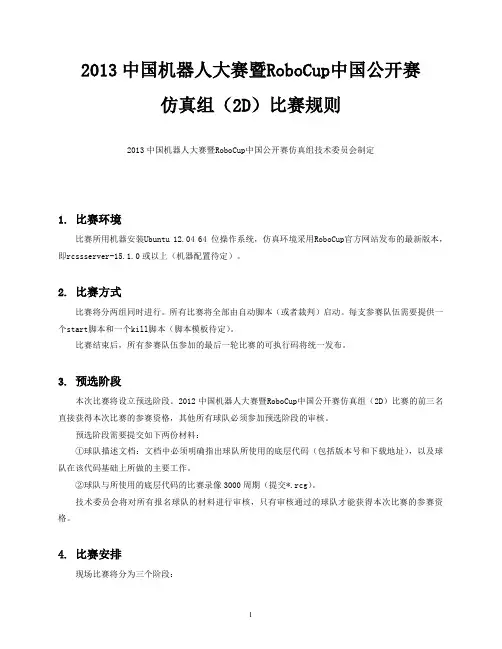
2013中国机器人大赛暨RoboCup中国公开赛仿真组(2D)比赛规则2013中国机器人大赛暨RoboCup中国公开赛仿真组技术委员会制定1. 比赛环境比赛所用机器安装Ubuntu 12.04 64 位操作系统,仿真环境采用RoboCup官方网站发布的最新版本,即rcssserver-15.1.0或以上(机器配置待定)。
2. 比赛方式比赛将分两组同时进行。
所有比赛将全部由自动脚本(或者裁判)启动。
每支参赛队伍需要提供一个start脚本和一个kill脚本(脚本模板待定)。
比赛结束后,所有参赛队伍参加的最后一轮比赛的可执行码将统一发布。
3. 预选阶段本次比赛将设立预选阶段。
2012中国机器人大赛暨RoboCup中国公开赛仿真组(2D)比赛的前三名直接获得本次比赛的参赛资格,其他所有球队必须参加预选阶段的审核。
预选阶段需要提交如下两份材料:①球队描述文档:文档中必须明确指出球队所使用的底层代码(包括版本号和下载地址),以及球队在该代码基础上所做的主要工作。
②球队与所使用的底层代码的比赛录像3000周期(提交*.rcg)。
技术委员会将对所有报名球队的材料进行审核,只有审核通过的球队才能获得本次比赛的参赛资格。
4. 比赛安排现场比赛将分为三个阶段:①小组赛:根据现场比赛的球队数目,小组赛分为若干轮进行,最终前8名的球队进入8强赛。
②8强赛:在8强赛中实行双败赛制,即任何一支队如果先后败给其他球队两次则被淘汰。
在8强赛中必须决出胜负,如果正常的比赛中双方打平,则进行2000周期的加时赛。
在加时赛中不采用金球法。
如果加时赛中仍不能决出胜负,则进行点球大战。
如果有一方不能正常进行点球,则能进行的一方获胜;如果双方都不能正常进行点球决战,则重赛一场。
③排名赛:对8强赛中被淘汰的球队两两进行排名的比赛。
5. 比赛积分规则①积分规则:在小组赛阶段,每支参赛队伍胜一场记3分、平一场记1分,负一场记0分。
②平分处理:在小组赛阶段,如果两个或两个以上的球队出现了积分相同的情况,则首先比较净胜球数,如相同则比较进球数,如再次相同则以相互成绩决定名次。
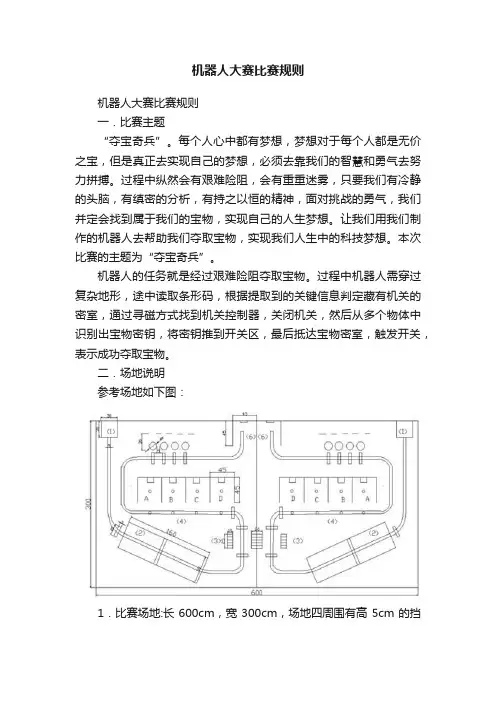
机器人大赛比赛规则机器人大赛比赛规则一.比赛主题“夺宝奇兵”。
每个人心中都有梦想,梦想对于每个人都是无价之宝,但是真正去实现自己的梦想,必须去靠我们的智慧和勇气去努力拼搏。
过程中纵然会有艰难险阻,会有重重迷雾,只要我们有冷静的头脑,有缜密的分析,有持之以恒的精神,面对挑战的勇气,我们并定会找到属于我们的宝物,实现自己的人生梦想。
让我们用我们制作的机器人去帮助我们夺取宝物,实现我们人生中的科技梦想。
本次比赛的主题为“夺宝奇兵”。
机器人的任务就是经过艰难险阻夺取宝物。
过程中机器人需穿过复杂地形,途中读取条形码,根据提取到的关键信息判定藏有机关的密室,通过寻磁方式找到机关控制器,关闭机关,然后从多个物体中识别出宝物密钥,将密钥推到开关区,最后抵达宝物密室,触发开关,表示成功夺取宝物。
二.场地说明参考场地如下图:1.比赛场地:长600cm,宽300cm,场地四周围有高5cm的挡板。
地板基本平整,场地左右两边镜像对称,表面材料为:白色免漆板。
场地中铺有黑色引导线,宽度为5cm。
一些地方设有交叉线标记位置,宽度5cm,长20cm。
2.启动区(图中标号[1]区)分红、蓝两区,分别由红线和蓝线圈定,双方机器人各占一个启动区,具体颜色由开赛前抽签决定。
机器人需在启动区识别场上开赛声音信号(一定频率的声音信号,持续一段时间后停止,声音开关由裁判长控制),自动开始比赛。
3.跷跷板(图中标号[2]区)面积:160cm×50cm,高度:30cm跷跷板中间有黑色引导线,板两端与地面平滑衔接,在跷跷板前10cm处有交叉线提示位置。
跷跷板中间有交叉线提示位置,交叉线长度同跷跷板宽度。
机器人需在跷跷板上停留一段时间,在20秒内使跷跷板两端同时离开地面的时间尽可能长,期间可多次通过跷跷板,取最长停留时间。
若最长停留时间不足20秒则比赛结束时在总完成时间上累加缺少时间的4倍。
4.解码区(图中标号[3]区)在黑色引导线两侧分别有一段总长度25cm、宽度10cm和总长度25cm、宽度20cm的条形码(后者为两个场地共用),距离引导线10cm。
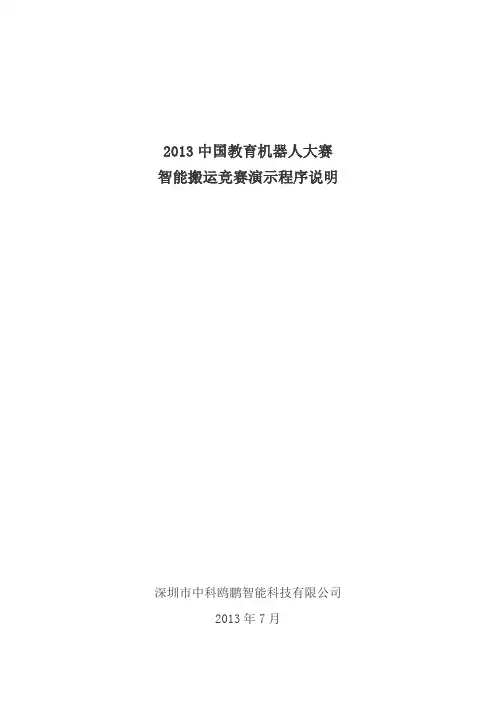
2013中国教育机器人大赛智能搬运竞赛演示程序说明深圳市中科鸥鹏智能科技有限公司2013年7月目录第一章智能搬运比赛简介 (3)1.1 比赛任务介绍 (3)第二章组装智能搬运机器人 (4)2.1 智能搬运机器人零件 (4)2.2 智能搬运机器人安装说明 (4)第三章超声波传感器测试说明 (7)3.1 超声波传感器技术参数介绍 (7)3.2 超声波测试程序 (8)第四章QTI线跟踪传感器测试说明 (10)4.1 QTI传感器技术参数介绍 (10)4.2 QTI传感器测试程序 (10)第五章智能搬运算法说明及程序 (12)5.1 智能搬运算法说明 (12)5.2 智能搬运程序 (13)第一章智能搬运比赛简介智能搬运是“中国教育机器人比赛”的一个比赛项目,智能搬运比赛是基于8位单片机的小型机器人比赛项目。
在比赛场地里移动,并将不同颜色的色块分类搬运到对应的位置。
比赛的记分根据机器人搬运物体安置位置的精度和完成任务时间来决定分值的高低。
该比赛模拟了工业自动化过程中自动化物流系统的实际工作过程,使参赛队员在实践中了解自动化物流系统的制作过程。
1.1 比赛任务介绍图1.1 智能搬运场地图如图1.1所示绿色区域为智能搬运场地的出发区。
机器人从出发区出发,到达物料储存区后,分拣其赛前1小时抽签决定好的任务,即先从5个预知颜色色块(黄、白、红、黑、蓝)按照顺序抽取4个颜色色块分别依次放到A,B,D,E位置,然后将剩下的1个色块通过抽签放到F、G、H和I中的一个位置。
在1小时内修改和调整程序,控制机器人运动,以便将5个颜色色块准确地搬运到对应的5个颜色中心区域内,最后回到出发区。
第二章组装智能搬运机器人2.1 智能搬运机器人零件⏹宝贝车车体一套⏹搬运手爪一个⏹超声波传感器一个⏹QTI线跟踪套件四个⏹C51+AVR教学板一个⏹导线和连接线若干⏹螺钉、螺母、铜柱和固定架若干⏹5-8V电源一个以下为部分智能搬运机器人零件的实物图。
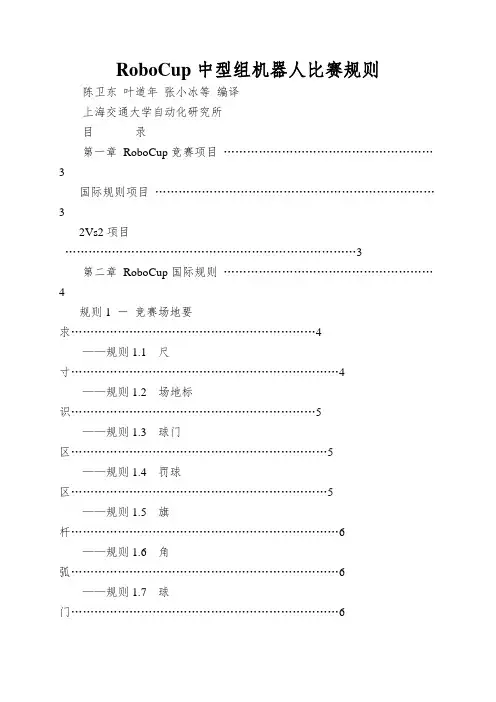
RoboCup中型组机器人比赛规则陈卫东叶道年张小冰等编译上海交通大学自动化研究所目录第一章RoboCup竞赛项目 (3)国际规则项目 (3)2Vs2项目 (3)第二章RoboCup国际规则 (4)规则1 -竞赛场地要求 (4)——规则1.1 尺寸 (4)——规则1.2 场地标识 (5)——规则1.3 球门区 (5)——规则1.4 罚球区 (5)——规则1.5 旗杆 (6)——规则1.6 角弧 (6)——规则1.7 球门 (6) (7)规则2 -竞赛所用球 (8)——规则2.1 质量和尺寸 (8)——规则2.2 受损球的替换 (8)规则3 -竞赛队员装备 (9)——规则3.1 安全性 (9)——规则3.2 差不多装备 (9)——规则3.3 守门员 (11)——规则3.4 犯规和制裁 (11)——规则3.5 重新竞赛 (11)规则4 -裁判及助理裁判 (12)——规则4.1 裁判之权威 (12)——规则4.2 权力与职责 (12)——规则4.3 助理裁判 (12)决 (12)规则5 -竞赛时刻 (13)——规则5.1 半场 (13)——规则5.1 中场休息 (13)——规则5.2 补时 (13)——规则5.3 罚球 (13)——规则5.3 加时 (13)——规则5.4 中途终止之竞赛 (13)规则6 -竞赛开始与重新开始 (14)——规则6.1 开球 (14)——规则6.2 开球过程 (14)——规则6.3 开球的犯规及措施 (14)规则7 -竞赛的进行与暂停 (15)——规则7.1 球赛暂停 (15)行 (15)规则8 -竞赛的计分 (16)——规则8.1 进球得分 (16)——规则8.2 竞赛胜利 (16)——规则8.3 竞赛规则 (16)规则9 -犯规行为 (17)——规则9.1 停球与持球 (17)——规则9.2 踢球与运球 (17)——规则9.3 犯规及其犯规后的处罚 (18)规则10 -任意球与罚球点及点球 (20)——规则10.1 任意球 (20)——规则10.2 任意球的位置 (20)——规则10.3 任意球犯规/制裁 (20)——规则10.4 罚球 (21)——规则10.5 球出边界的处理 (22)——规则10.6 球门发球 (22)规则11- 上场队员的人数 (23)第三章RoboCup 2Vs2项目规则 (24)3.1 2Vs2竞赛差不多规则 (24)3.2 2Vs2竞赛其它规则 (24)RoboCup竞赛项目RoboCup的原意为机器人世界杯(Robot World Cup)。
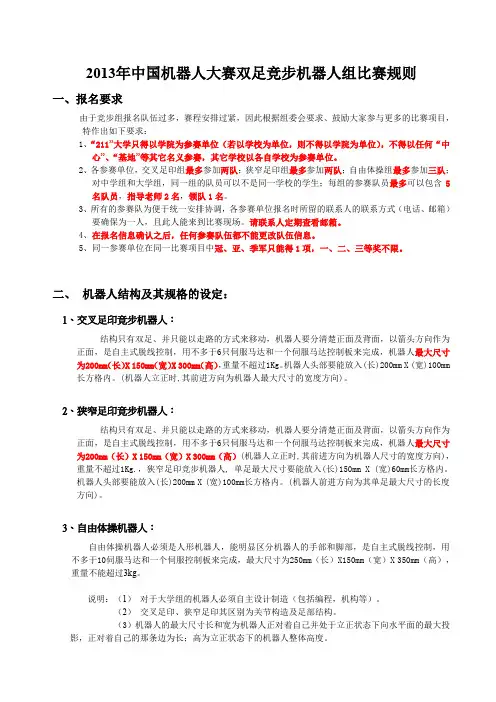
2013年中国机器人大赛双足竞步机器人组比赛规则一、报名要求由于竞步组报名队伍过多,赛程安排过紧,因此根据组委会要求、鼓励大家参与更多的比赛项目,特作出如下要求:1、“211”大学只得以学院为参赛单位(若以学校为单位,则不得以学院为单位),不得以任何“中心”、“基地”等其它名义参赛,其它学校以各自学校为参赛单位。
2、各参赛单位,交叉足印组最多参加两队;狭窄足印组最多参加两队;自由体操组最多参加三队;对中学组和大学组,同一组的队员可以不是同一学校的学生;每组的参赛队员最多可以包含5名队员,指导老师2名,领队1名。
3、所有的参赛队为便于统一安排协调,各参赛单位报名时所留的联系人的联系方式(电话、邮箱)要确保为一人,且此人能来到比赛现场。
请联系人定期查看邮箱。
4、在报名信息确认之后,任何参赛队伍都不能更改队伍信息。
5、同一参赛单位在同一比赛项目中冠、亚、季军只能得1项,一、二、三等奖不限。
二、机器人结构及其规格的设定:1、交叉足印竞步机器人:结构只有双足、并只能以走路的方式来移动,机器人要分清楚正面及背面,以箭头方向作为正面,是自主式脱线控制,用不多于6只伺服马达和一个伺服马达控制板来完成,机器人最大尺寸为200mm(长)X 150mm(宽)X 300mm(高),重量不超过1Kg。
机器人头部要能放入(长)200mm X (宽)100mm 长方格内。
(机器人立正时,其前进方向为机器人最大尺寸的宽度方向)。
2、狭窄足印竞步机器人:结构只有双足、并只能以走路的方式来移动,机器人要分清楚正面及背面,以箭头方向作为正面,是自主式脱线控制,用不多于6只伺服马达和一个伺服马达控制板来完成,机器人最大尺寸为200mm(长)X 150mm(宽)X 300mm(高)(机器人立正时,其前进方向为机器人尺寸的宽度方向),重量不超过1Kg.,狭窄足印竞步机器人, 单足最大尺寸要能放入(长)150mm X (宽)60mm长方格内。
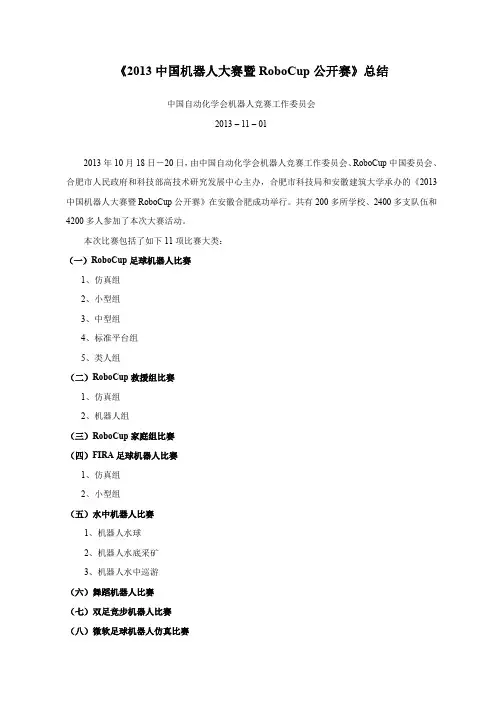
《2013中国机器人大赛暨RoboCup公开赛》总结中国自动化学会机器人竞赛工作委员会2013 – 11 – 012013年10月18日-20日,由中国自动化学会机器人竞赛工作委员会、RoboCup中国委员会、合肥市人民政府和科技部高技术研究发展中心主办,合肥市科技局和安徽建筑大学承办的《2013中国机器人大赛暨RoboCup公开赛》在安徽合肥成功举行。
共有200多所学校、2400多支队伍和4200多人参加了本次大赛活动。
本次比赛包括了如下11项比赛大类:(一)RoboCup足球机器人比赛1、仿真组2、小型组3、中型组4、标准平台组5、类人组(二)RoboCup救援组比赛1、仿真组2、机器人组(三)RoboCup家庭组比赛(四)FIRA足球机器人比赛1、仿真组2、小型组(五)水中机器人比赛1、机器人水球2、机器人水底采矿3、机器人水中巡游(六)舞蹈机器人比赛(七)双足竞步机器人比赛(八)微软足球机器人仿真比赛(九)机器人武术擂台赛(十)机器人游中国比赛(十一)其它1、助老机器人比赛2、家庭服务机器人比赛3、家庭机器人仿真比赛4、医疗与服务机器人比赛5、机器人智能搬运比赛6、机器人创新比赛7、仿人机器人竞速比赛8、采摘机器人比赛本次比赛是历届比赛中比赛种类最多和规模最大的一次。
本次赛事包括了两个比赛:一个是2013中国机器人大赛,它既包括如RoboCup和FIRA等国际上的标准比赛项目,同时也包括了如水中机器人比赛、舞蹈机器人比赛、双足竞步机器人比赛、机器人武术擂台赛、机器人游中国、机器人智能搬运、仿人机器人竞速比赛、采摘机器人以及医疗、助老、服务机器人等自创的比赛项目。
另一个是2013 RoboCup 中国公开赛,它是RoboCup 国际赛事的一个组成部分。
10月19日上午,本次大赛隆重开幕。
中国自动化学会理事长戴汝为院士、中国自动化学会机器人竞赛工作委员会顾问中南大学蔡自兴教授、中国自动化学会机器人竞赛工作委员会名誉主任孙增圻教授,中国自动化学会机器人竞赛工作委员会顾问中国科技大学王煦法教授、中国自动化学会机器人竞赛工作委员会副主任原魁研究员、陈小平教授、佟国锋教授、陈万米教授、谢广明教授、副主任兼秘书长李实博士,合肥副市长吴建国、合肥市科技局副局长陈明义、安徽建筑大学校长方潜生教授、安徽建筑大学电子与信息工程学院党委书记张润梅教授等专家和领导出席了开幕式。
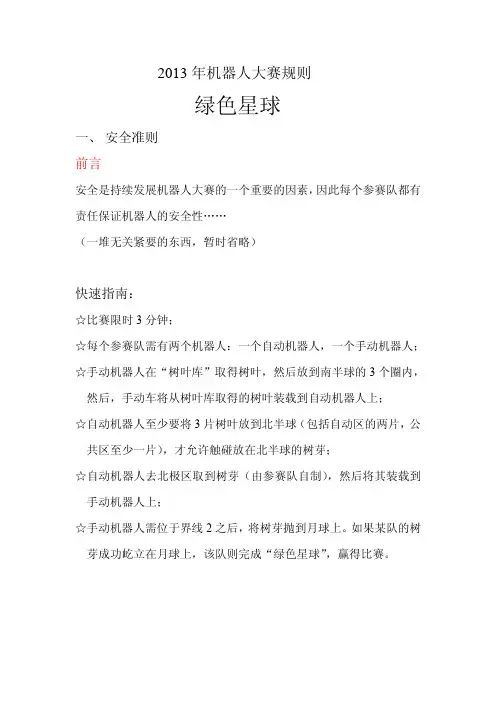
2013年机器人大赛规则绿色星球一、安全准则前言安全是持续发展机器人大赛的一个重要的因素,因此每个参赛队都有责任保证机器人的安全性……(一堆无关紧要的东西,暂时省略)快速指南:☆比赛限时3分钟;☆每个参赛队需有两个机器人:一个自动机器人,一个手动机器人;☆手动机器人在“树叶库”取得树叶,然后放到南半球的3个圈内,然后,手动车将从树叶库取得的树叶装载到自动机器人上;☆自动机器人至少要将3片树叶放到北半球(包括自动区的两片,公共区至少一片),才允许触碰放在北半球的树芽;☆自动机器人去北极区取到树芽(由参赛队自制),然后将其装载到手动机器人上;☆手动机器人需位于界线2之后,将树芽抛到月球上。
如果某队的树芽成功屹立在月球上,该队则完成“绿色星球”,赢得比赛。
1、参赛队成员1.1 每个参赛队需由同一所院校的三个学生和一个指导老师组成,只有这三名学生能够进入比赛场地。
1.2 参赛队成员在国际赛期间必须仍就读于该队所属的院校,在参加国内选拔赛时未毕业的队员除外。
1.3 研究生不得以任何方式参与机器人的制作过程。
2、比赛场地和物体2.1比赛场地包括一个尺寸为13000mmX13000mm的区域(由涂上乳胶的胶合板制作)和一个包围该区域的铁制围栏(100mm高,50mm 厚)。
比赛场地被一个铁制围栏(60mm高,30mm厚)沿着本初子午线均分。
2.2比赛场地按以下准则分为两部分:2.2.1地球区(详见图)2.2.1.1 地球区为圆形,直径为8500mm。
30mm宽的亚光白线代表经线和纬线。
2.2.1.2 一棵绿树的图案被画在地球区内。
2.2.1.3 在每个队的地球区有7个钢圏(涂成绿色)用于放置树叶。
每个圈尺寸如下:50mm高,25mm厚,内圈直径为350mm。
公共区钢圈所处位置的场地被涂成黄色,其它的钢圈所处位置的场地则被涂成白色(详见图)2.2.1.4 北半球(详见图)是地球区的上半部分。
公共区占据北半球中心的4块小区(详见图)。
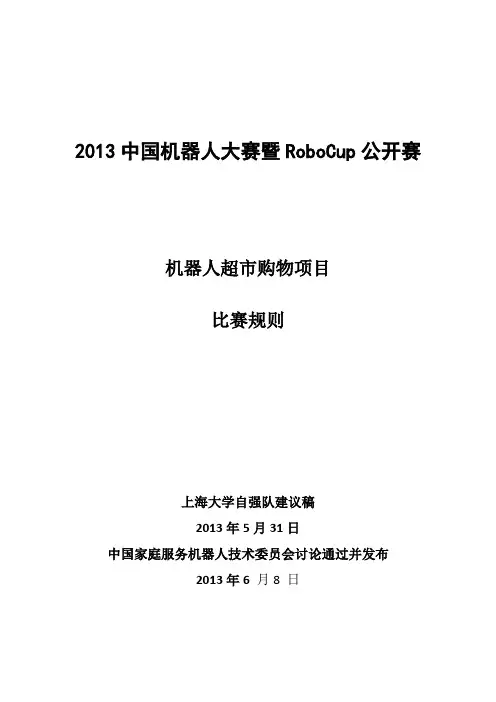
2013中国机器人大赛暨RoboCup公开赛机器人超市购物项目比赛规则上海大学自强队建议稿2013年5月31日中国家庭服务机器人技术委员会讨论通过并发布2013年6 月8 日前言中国服务机器人正处在一个快速发展的阶段,为了提高各研究单位参与服务机器人比赛的积极性,同时也为了各研究单位的交流与合作,同时鉴于2012中国服务机器人大赛上各个参赛队伍水平的不均衡性,为使国内的服务机器人能够更好更快的发展,在原有比赛规则上将做出一些改进,希望更多的高校来参与,在比赛中充分体现研究单位在某一方向做出的突出成果。
中国家庭服务机器人技术委员会鼓励参与该项比赛的队伍,在比赛中尽可能展示出更全面的服务机器人功能。
一、赛事规则(1)安全:任何一台参加比赛的机器人都必须安全操作,即不对人和环境造成危害。
大赛规定每台机器人都要将电源开关设立在容易操作的地方。
每台机器人必须有急停按钮。
赛前由技术委员会检查。
(2)机器人尺寸:高度在80厘米~200厘米之间;最大重量为150千克;机器人应可以通过一个常规门道(高 180 厘米,宽70厘米)。
(3)机器人自主性,不允许人们对机器人进行直接控制(或遥控)。
(4)时间限制:每项比赛都有时间限制,每支队伍必须在规定时间内完成比赛,一旦时间耗尽则比赛结束。
赛前每支队伍有 2分钟的准备时间,准备时间结束则立即开始计时进入比赛,也可在准备时间内开始比赛,但比赛时间不增加。
(5)比赛中允许机器人有一次重启机会,但是比赛中流失的时间不补。
如果重启后得分比重启前高,取重启后的得分,否则取两次得分的平均值。
(6)资格认证:所有报名参赛队伍必须在 2013 年9 月 20 日之前提交资格认证材料(TDP(队伍描述文档)、 Team Video、发表的相关论文材料等), Team Video发到公网,如优酷等,把该链接以及其他所有材料发到家庭服务机器人组的邮件列表robocuphome_china@,由家庭服务机器人组技术委员会评定是否准予该队参赛。
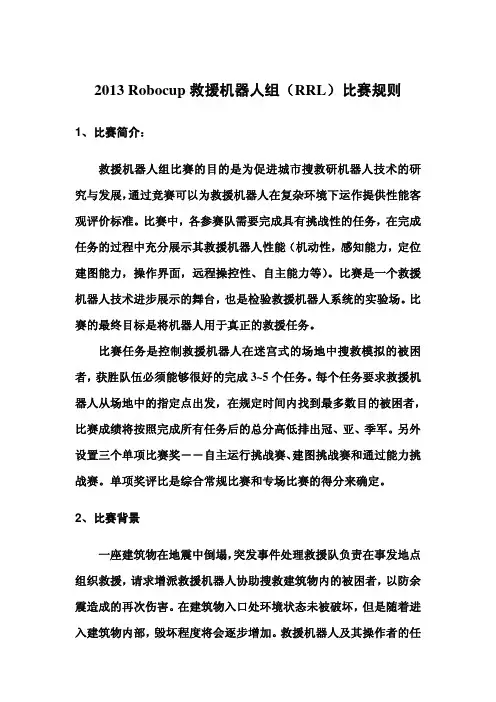
2013 Robocup救援机器人组(RRL)比赛规则1、比赛简介:救援机器人组比赛的目的是为促进城市搜救研机器人技术的研究与发展,通过竞赛可以为救援机器人在复杂环境下运作提供性能客观评价标准。
比赛中,各参赛队需要完成具有挑战性的任务,在完成任务的过程中充分展示其救援机器人性能(机动性,感知能力,定位建图能力,操作界面,远程操控性、自主能力等)。
比赛是一个救援机器人技术进步展示的舞台,也是检验救援机器人系统的实验场。
比赛的最终目标是将机器人用于真正的救援任务。
比赛任务是控制救援机器人在迷宫式的场地中搜救模拟的被困者,获胜队伍必须能够很好的完成3~5个任务。
每个任务要求救援机器人从场地中的指定点出发,在规定时间内找到最多数目的被困者,比赛成绩将按照完成所有任务后的总分高低排出冠、亚、季军。
另外设置三个单项比赛奖――自主运行挑战赛、建图挑战赛和通过能力挑战赛。
单项奖评比是综合常规比赛和专场比赛的得分来确定。
2、比赛背景一座建筑物在地震中倒塌,突发事件处理救援队负责在事发地点组织救援,请求增派救援机器人协助搜救建筑物内的被困者,以防余震造成的再次伤害。
在建筑物入口处环境状态未被破坏,但是随着进入建筑物内部,毁坏程度将会逐步增加。
救援机器人及其操作者的任务就是确定现场环境、寻找被困者,并将获得的信息(被困者位置和状态)标记在救援机器人所建立的现场地图上。
3、评分依据比赛主要考核的机器人性能包括以下几个方面:⏹能够通过危险,倒塌和杂乱的环境;⏹确定被困者状态和被困者位置;⏹自动建立环境地图;⏹机器人的自主运行能力。
在比赛中展示机器人的其他性能也会被提倡和受到欢迎,包括:⏹递送救援物资;⏹安置传感器及监控环境;⏹标示和计算到达被困者距离最近的路径;⏹帮助被困者脱离危险(比如提供对建筑结构的支撑或其他安全措施,帮助被困者逃脱)。
4、场地特征场地分为:黄区,桔区,红区。
黄区是(处处是倾斜地面的?)迷宫地域,桔区是楼梯、斜坡、高台等组成的障碍区域,红区是在桔区场地基础上增加立方体地板组成的障碍。
机器人大赛规则解释l RoboCup足球机器人仿真组(2D、3D)仿真组比赛类似FIFA系列足球游戏,比赛由程序自主控制,完全模拟真人比赛,可设定阵形、战术、体力消耗等一系列参数。
比赛上下半场各5分钟,由电脑裁判进行在线裁定。
三维仿真与二维仿真相比,实现了对空间的模拟实战,使比赛更加激烈,更具观赏性。
l RoboCup足球机器人小型组比赛在5.5m×4m的绿色地毯场地上进行,采用桔黄色的高尔夫球作为比赛用球,每队由5个机器人组成。
机器人的体积不超过180cm2,高度不超过150mm。
机器人拥有控球、击球装置,可以和赛场外的计算机进行无线通信。
比赛规则与一般足球相似,有点球、任意球、门球、犯规、红黄牌等,上下半场各10 分钟。
l RoboCup足球机器人中型组(2:2 4:4)中型组比赛分为每队2个和每队4个机器人两种不同类型,使用橙色的国际足联标准5号用球,上下半场各10分钟。
机器人的尺寸不超过0.5m×0.5m ×0.8m,在比赛过程中完全自主控制。
l RoboCup足球机器人四腿组四腿机器人足球赛统一使用Sony公司生产的“爱宝”(AIBO)机器狗作为比赛专用机器人,比赛在4.2m×2.8m的绿色场地上进行。
比赛双方各有四个机器人上场,上下半场各10分钟,队员之间可以进行无线通讯,但禁止任何形式的远程控制,从而保证每一支球队都是一个独立系统。
l RoboCup足球机器人类人组比赛以各队自己开发的人形机器人作为比赛专用机器人,分为规定动作部分和自由发挥部分。
规定动作包括单腿站立一分钟、行走、踢球、点球比赛等,自由发挥部分,每队有5分钟时间展示机器人的各个动作,由裁判从技术和艺术两方面进行评分。
l RoboCup救援组比赛“灾难营救”是个重要的社会议题,机器人营救项目在模拟的事故现场寻找及营救受害者,分仿真组和机器人组两个组别。
旨在激发研究创意,使得机器人可以取代人力,在恶劣的环境下进行营救工作。
中国机器人大赛(合肥)“机器人旅游”竞赛规则一、竞赛类别、目的、机器人及报名要求二、场地、路线与环境三、旅游景点四、比赛程序五、赛前准备工作六、计时计分七、其他附件一、景点分值表附件二、本次旅游比赛路线图一、竞赛类别、目的、机器人及报名要求§1.1竞赛级别类型设置本次比赛共设置10个竞赛项目,探险类5个,寻宝类5个。
2、寻宝游§1.2 竞赛目的探险类旅游竞赛,要求机器人在规定假期时间内,游历尽量多的景点,获得尽量多的得分,并在假期结束前回到出发地。
寻宝类旅游竞赛,要求机器人在规定假期时间内,去随机指定的宝物所在景点寻宝,同时游历尽量多的景点,获得尽量多的得分,并在假期结束前回到出发地。
本类机器人竞赛的目的是引导参赛队研究、设计并制作具有优秀硬件与软件系统的移动机器人,逐步提高机器人多方面的能力与智能,如:a、系统规划与优化能力:在预定的假期时间内游历尽量多的景点,完成计划中的旅游活动,并回到出发地点。
是一种最优规划活动;有一定的系统规划与优化能力。
想得高分,就要游历尽量多的景点和难度高的景点,但存在来不及在规定的假期内回家的危险。
每一轮比赛中走两次,使得第一次旅游探路,其后进行自动路径优化成为可能。
b、应变能力:旅游路线可能在比赛开始前很短的时间内正式公布;有些可移动景点与路障的摆放数量与位置,在机器人放进出发区后,随机确定。
这在一定程度上可控制竞赛的难度,并使旅游路线有一定的不确定性。
c、视力:考验机器人辨别数字、文字、形状和色彩的能力,引导机器人视觉能力的提高。
d、爬坡能力:对于Ⅱ型和Ⅲ型机器人难度更大。
e、跨越门槛的能力:这对三类机器人都是重大考验。
f、快速性与稳定性。
机器人在的整个旅游过程中,始终要在快速性与稳定性中间求得平衡,否则,难以取得好的成绩。
§1.3 机器人机器人应该有便于操作的启动与停止按钮。
机器人尺寸形状要适应旅游场地与景点,不得伤害人,不得损坏场地、景点与环境。
机器人武术擂台赛项目竞赛规程(2013)1 总则1.1竞赛目的本项赛事的目的在于促进智能机器人技术的普及。
参赛队需要在规则范围内以各自组装或者自制的自主机器人互相格斗,并争取在比赛中获胜,以对抗性竞技的形式来推动机器人技术在大学生、青少年中的普及与发展。
本项赛事未来的发展目标是两方面:1)较高技术难度:要求两组使用双腿自主行走的仿人形机器人互相格斗,将对方打倒或者打下擂台。
2)较强的观赏性和对抗性:较大尺寸、不限定形态、具备攻击装置的机器人的遥控或自主性对抗。
1.2 竞赛内容概述在指定的擂台上有双方机器人。
双方机器人模拟中国传统擂台格斗的规则,互相击打或者推挤。
如果一方机器人整体离开擂台区域或者不能再继续行动或被对方机器人打倒,则另一方获胜。
本规则的原则是规定参赛队不能做的方面,即本规则没有明确禁止的做法均是允许的,除非技术委员会认为该事项可能危害人身安全和比赛过程的安全及公正。
对于由本规则未能描述到的盲区或疑问点导致的争议,在比赛现场应服从主裁判裁决,赛后可由参赛队申请仲裁或解释,由技术委员会合议后进行书面的解释判定,并正式列入规则中。
1.3 竞赛组别机器人武术擂台赛分为以下十个组别,其中包含不限定比赛平台和限定标准平台的竞赛。
如任何参赛队对自身或其他队伍是否具备参加该组别的资格有争议,应在赛前以书面方式提交技术委员会讨论裁定。
不限定平台赛种:●1) 无差别组(1VS1)⏹不限制参赛机器人结构形式,可以采用轮式、履带式、足式移动。
●2) 仿人组(1VS1)⏹参赛机器人必须具备几个明显的仿人类特征,见本规则2.2节。
●3) 技术挑战赛(1规定动作挑战;2动作投影技术挑战;3 自主命题技术挑战)⏹技术挑战赛的内容原则上是未来将引入正式比赛的内容,也是本赛事规则发展的风向标。
标准平台赛种:●4) 无差别组标准平台(1VS1和2VS2)⏹每个参赛机器人的任何部分(除电池外)都只能使用同一厂家提供的机器人套件中的部件完成,结构件只能使用塑料部件,例如创意之星和乐高套件等。
RoboCup中型组机器人比赛规则(MSLR)陈卫东叶道年张小冰等编译上海交通大学自动化研究所目录第一章RoboCup比赛项目 (3)1.1国际规则项目 (3)1.22Vs2项目 (3)第二章RoboCup国际规则 (4)●规则1 -比赛场地要求 (4)——规则1.1 尺寸 (4)——规则1.2 场地标识 (5)——规则1.3 球门区 (5)——规则1.4 罚球区 (5)——规则1.5 旗杆 (6)——规则1.6 角弧 (6)——规则1.7 球门 (6)——规则1.8 安全 (7)●规则2 -比赛所用球 (8)——规则2.1 质量和尺寸 (8)——规则2.2 受损球的替换 (8)●规则3 -比赛队员装备 (9)——规则3.1 安全性 (9)——规则3.2 基本装备 (9)——规则3.3 守门员 (11)——规则3.4 犯规和制裁 (11)——规则3.5 重新比赛 (11)●规则4 -裁判及助理裁判 (12)——规则4.1 裁判之权威 (12)——规则4.2 权力与职责 (12)——规则4.3 助理裁判 (12)——规则4.4 裁判判决 (12)●规则5 -比赛时间 (13)——规则5.1 半场 (13)——规则5.1 中场休息 (13)——规则5.2 补时 (13)——规则5.3 罚球 (13)——规则5.3 加时 (13)——规则5.4 中途终止之比赛 (13)●规则6 -比赛开始与重新开始 (14)——规则6.1 开球 (14)——规则6.2 开球过程 (14)——规则6.3 开球的犯规及措施 (14)●规则7 -比赛的进行与暂停 (15)——规则7.1球赛暂停 (15)——规则7.2 球赛进行 (15)●规则8 -比赛的计分 (16)——规则8.1 进球得分 (16)——规则8.2 比赛胜利 (16)——规则8.3 竞赛规则 (16)●规则9 -犯规行为 (17)——规则9.1 停球与持球 (17)——规则9.2 踢球与运球 (17)——规则9.3 犯规及其犯规后的处罚 (18)●规则10 -任意球与罚球点及点球 (20)——规则 10.1 任意球 (20)——规则10.2 任意球的位置 (20)——规则10.3 任意球犯规/制裁 (20)——规则10.4 罚球 (21)——规则10.5 球出边界的处理 (22)——规则10.6 球门发球 (22)●规则11- 上场队员的人数 (23)第三章RoboCup 2Vs2项目规则 (24)3.1 2Vs2比赛基本规则 (24)3.2 2Vs2比赛其它规则 (24)第一章RoboCup比赛项目RoboCup的原意为机器人世界杯(Robot World Cup)。
RoboCup Standard Platform League(NAO)Rule BookRoboCup Technical Committee(2013rules,as of May21,2013)Contents1Setup of the Environment1 2Robot Players4 3Game Process7 4Forbidden Actions and Penalties18 5Judgement25 6Changes From201227 7Questions/Comments281Setup of the Environment1.1Field ConstructionThe soccerfield is built on a total carpet area of length10.4m and width7.4m.The dimensions of the soccerfield are shown in Figure1.The construction and placement of the goals is depicted in Figure2and Figure3.ID Description Length(in mm)A Field length9000B Field width6000C Line width50D Penalty mark size100ID Description Length(in mm)E Penalty area length600F Penalty area width2200G Penalty mark distance1800H Center circle diameter1500I Border strip width700Figure1:Schematic diagram of the soccerfield(not to scale).and corresponding dimensions in mm.Figure2:Dimensions of the goal(in mm),viewed from above and its placement on thefield.The goalposts and crossbar are made from3yel-low cylinders with a diameter of10cm.The net:•has a height of80cm•is of white,grey or black color•is properly supported,in a way to mini-mize interference with the goal keeper•is attached to thefield to catch the ball•has a weave with holes smaller than theball diameter.Figure3:Appearance and dimensions of the goals.The support structure for the net shall be made with small white bars or cylinders as shown in Figure3.Figure4:Field colors and layout.1.2Throw-in LinesIn addition to the visible lines,there are two invisible lines only relevant to the throw-in procedure (see Section3.10),but not relevant to the construction of thefield.These two throw-in lines are 400mm away from the sidelines and run parallel to them inside the playing area.Each throw-in line is7m long.The throw in lines will be marked(as dots at the end of the throw in lines and short dashes along the line)by the technical committee at the start of competition with a felt-tip pen—these lines are intended to stay invisible to robots but provide a guide to referees.1.3Field ColorsThe colors of the soccerfield are shown in Figure4.All items on the RoboCupfield are color-coded:•Thefield(carpet)itself is green(color is not specified,but it should not be too dark).•The lines on thefield are white.•Goals(cf.Figure3).The posts and top cross bar of both goals are yellow(RAL1018).Thenet is white,grey,or black.The support structure for the net is white.1.4Lighting ConditionsThe lighting conditions depend on the actual competition site.Only ceiling lights may be used. 1.5Venue SetupFields may be located close to one another.Barriers will not necessarily be constructed between adjacentfields to block the robots from seeing otherfields,goals,or balls.However,barriers will be constructed to block sight between anyfields that are not located at least three meters apart. Hence,for each side of afield that is adjacent to anotherfield,either barriers will separate the fields or at least three meters will be between the carpet of adjacentfields.1.6BallThe official ball will be a Mylec orange street hockey ball.They are65mm in diameter and weigh 55grams.These are the shiny balls and are not gel-filled.They are no-bounce warm weather(60 to75degrees Fahrenheit)hockey balls.These balls are available at a few locations:•/Mylec-Weather-Bounce-Hockey-Orange/dp/B002LBDA30/ref=sr_1_18?ie=UTF8&s=sporting-goods&qid=1259775748&sr=8-18•/mylec-orange-warm-weather-ball.html 2Robot PlayersA match is played by two teams,each consisting of not more than5players.At most one may be designated as goalkeeper,the others are allfield players.2.1HardwareAll teams must use NAO humanoid robots manufactured by Aldebaran Robotics.Absolutely no modifications or additions to the robot hardware are allowed.No additional hardware is permitted including off-board sensing or processing systems.Additional sensors besides those originally installed on the robots are likewise not allowed.The only exceptions are:•Attaching the jersey numbers provided by the league to the robots.•Adding black and white sponsor or team logos to the upper legs of the robots(cf.Figure6).These logos must be at least50%white by area.•Adding small black and white stickers to the torso of the robots stating the name of the robot, the name of the team,or similar information.These stickers must be at least50%white by area.•Setting the passive wrist joints to afixed position either with glue or a transparent or white duct tape.•Protecting thefingers with transparent or white duct tape.•Use of alternate memory sticks in replacement of the Aldebaran supplied memory sticks.A computer will be provided by the event organizers for the purpose of sending GameController messages to the robots.2.2Goal KeeperThe goal keeper is the only player that is allowed to enter the penalty area of its own team.The goal keeper is allowed to touch the ball with its arms/hands only while it is within its own penalty area.It always has the jersey number“1”.2.3Field PlayersThefield players are not allowed to enter their own penalty area.The fourfield players robots have the jersey numbers“2”,“3”,“4”and“5”.2.4Team MarkersRobots will use colored jersey shirts as team markers.The official jersey shirt colors are cyan and magenta(referred to as blue and red throughout this document).Each jersey shirt will have a player number(1-5)printed on it in white text.The official jersey shirts will be available for purchase by each team—details regarding purchase of official jersey shirts will be sent via email to all teams. Teams must purchase the official jersey shirts as specified in this email—teams are not allowed to use jersey shirts that they design themselves or that are manufactured by a different supplier.An example of how the team markers are worn is shown in Figure5.2.5CommunicationsThe robots should play without human munication is only allowed among robots on thefield and between the robots and the GameController.2.5.1Acoustic CommunicationsThere are no restrictions on communication between the robots using a microphone or a speaker.2.5.2Wireless CommunicationsThe only wireless hardware allowed to be used by the teams are the wireless network cards built into the NAOs,and the access points provided by the event organizers.All other wireless hardware must be deactivated.A team may be disqualified if one of the team members violates this rule. The MAC-addresses of all NAOs participating in the competition will be registered.Only these MAC-addresses can be reached through the access points provided by the event organizers.In addition,the access points will be secured by different SSIDs and WEP keys.Each team will get a range of IP addresses that can be used both for their robots and their com-puters.The IP addresses,channels,SSIDs,and WEP keys of thefields will be announced at the competition site.Teams can use a bandwidth of up to500Kbps of the wireless.This includes any data transferred, namely the actual payload and any protocol overhead created,e.g.,by TCP,UDP,or the Game-Controller.Any form of wireless robot-to-robot communication is allowed,as long as it uses the access points provided by the event organizers(using the so-called ad-hoc mode is prohibited),it does not con-flict with TCP/IP or UDP,and the maximum bandwidth allowed for each team is not exceeded.a)b)c)Figure5:Preliminary version of team markers.a)Front view.b)Side view.c)Back view.Each team will be assigned a range of IP-addresses that can be used for direct robot-to-robot com-munication.Each team will also be allocated a limited range of UDP ports on which broadcast will be permitted.The GameController will use UDP to connect to the robots.The source distribution of the Game-Controller provides the headerfile RoboCupGameControlData.h that defines all messages sent by the GameController to the robots.They correspond to the robot states described in Section3.2. The use of remote processing/sensing is prohibited.3Game Process3.1Structure of the GameA game consists of three parts,i.e.thefirst half,a half-time break,and the second half.Each half is10minutes counted from the initial kick-off.The clock stops during stoppages of play1(such as ready and set state after goals).The extra time over ten minutes total is referred to as“lost time”. The half-time break is also ten minutes—during this time both teams may change robots,change programs,or do anything else that can be done within the time allotted.In round robin pool play, a game canfinish in a draw as no penalty shoot-out will follow.In the intermediate round,quarter finals,semifinals,or3rd place,orfinal a game that ends in a draw will be followed by a penalty shoot-out(see Section3.9).The teams will change the goal defended and color of the team markers during the half-time break.1This may not be the case until the quarterfinals.Figure6:Example Sponsor/Team Logo placement.Figure7:Robot states.Button interface transitions are shown in gray.GameController transitions are shown in black.However,any transition possible can actually be sent by the GameController.3.2Robot StatesRobots can be in six different states(cf.Figure7).If the wireless is available,these states will be set by the GameController.Teams must implement code to receive and correctly respond to wireless GameController packets,and also give indication of the game state,team color,and the kickoff state.If a robot does not respond to either the game controller or the button press interface, then it is not included in the game,and the game starts without the offending robot.Initial.After booting,the robots are in their initial state.In this state,the button interface for manually setting the team color and whether the team has kick-off is active.The robots are not allowed moving in any fashion besides initially standing up.Pressing the left foot bump sensor will switch the team color.Shortly pressing the chest button will switch the robot to the penalized state.Ready.In this state,the robots walk to their legal kick-off positions(cf.Section3.6).They remain in this state,until the head referee decides that there is no significant progress anymore (after a maximum of45seconds).This state is not available if only the button interface is implemented.Robots may be disentangled by the referees at the start of the Ready state.After that,the “Player Pushing”rules are applied,but the penalty is manual placement by the assistant referees(cf.Section3.6),not the penalty described in Section4.9.Consequently those pushings do not go into the permanent removal count.Set.In this state,the robots stop and wait for kick-off(cf.Section3.6).If they are not at legal positions,they will be placed manually by the assistant referees to the positions shown in Figure8.They are allowed to move their heads before the game(re)starts but they are not allowed to move their legs or locomote in any fashion.This state is not available if only the button interface is implemented.Robots that do not listen to the GameController will be placed manually.Until the game is(re)started,they are in the penalized state.Playing.In the playing state,the robots are playing soccer.Shortly pressing the chest button will switch the robot to the penalized state.Penalized.A robot is in this state when it has been penalized.It is not allowed to move in any fashion,i.e.also the head has to stop turning.Shortly pressing the chest button will switch the robot back to the playing state.Finished.This state is reached when a half isfinished.This state is not available if only the button interface is implemented.The team color should be displayed during the whole game on the LED of the left foot(blue/red). Teams that support the GameController can visualize whether the robot’s team has kick-off on the LED of the right foot(off/white)in the states initial,ready and set.The current game state should be displayed on the LED in the torso.The colors corresponding to the game states are:•Initial:Off•Ready:Blue•Set:Yellow•Playing:Green•Penalized:Red•Finished:Off3.3GoalA goal is achieved when the entire ball(not only the center of the ball)goes over the goal-side edge of the goal line,i.e.the ball is completely inside the goal area2.The restart after the goal shall adopt the same rules as the kick-off.Note that a goal can never be awarded where the last contact of the ball with a robot was by the arm or hand(even if unintentional–see also Section4.10)of an attacking robot.Should the ball enter the goal area where the last contact is accidental contact with the arm or hand of an attacking robot,the goal shall not count and a goal kick is awarded,that is,it shall count as if the ball is out by the attacking team(see Section3.10).2The goal line is part of thefield.3.4Applying PenaltiesSee Section4.2.3.5Initial Kick-offThefirst kick-off at the start of each half time is the initial kick-off.Before the initial kick-off, i.e.before the start of each half,all robots must be in the initial state and must be placed on the sidelines in their own half of thefield.It is up to the team as to which sideline(s)and where exactly on the sidelines the robots are placed.Once the robots receive the ready signal from the GameController,they are to proceed as described in Section3.6.3.6Kick-offFor kick-off,the robots listening to the wireless GameController run through three states:ready, set,and playing.Robots not listening to the GameController are simply penalized and manually placed for kick-off3.In the ready state,the robots should walk to their legal kick-off positions.These positions are always located inside their own side of thefield.No player is allow to touch the halfway line.The field players of the attacking team can walk to any position within their own half(including inside the center circle),except for inside the penalty area.Thefield players of the defending team can walk to any position within their own half,except for inside the center circle and the penalty area. The feet of both goal keepers must be inside the penalty area.If robots collide during the autonomous placement,the“Player Pushing”rules are applied,but the penalty is manual placement by the assistant referees,not the penalty described in Section4.9. Consequently those pushings do not go into the permanent removal count.The robots have a maximum of45seconds to reach their positions.If all the robots have reached legal positions and have stopped,or if45seconds have passed,the robots will be switched into the set state,in which they must stop walking.Each robot that is not at a legal position at this point in time will be placed manually by the assistant referees to the positions as shown in Figure8.Robots that are legally positioned will not be moved by the assistant referees unless a manual position is requested by the team leader.In the case where the team leader requests manual placement,all robots on that team are manually positioned.There are extra restrictions on the legal positions of manually positioned robots.The kicking-off robot is placed on the center circle,right in front of the penalty mark.Its feet touch the line,but 3Note that robots being manually placed because they are not listening to the GameController must still be placed in the restricted set of legal positions for manually placed robots.It is to a team’s advantage to have their robots listen to the GameController.Figure8:Manual setup for kick-off.they are not inside the center circle.One of the otherfield players of the attacking team is placed in front of one of the goal posts on the height of the penalty mark(i.e.the virtual intersection point of the goal post and the penalty mark)and the other two are placed on the corners of the penalty box without having their feet touching the corners.Twofield players of the defending team are placed halfway between the corners of their own penalty box and the sidelines.The other twofield players of the defending team are placed immediately in front of their own penalty box,halfway between the center of the penalty box and the goal post.The goal keepers for each team are placed at the center of the penalty box,with their feet immediately in front of the end-line.As autonomously placed robots are allowed to be much closer to the ball,successful autonomous placement results in a significant advantage over manual placement.Just before the set state is called,the ball is placed on the center point of the center circle by one of the referees.If it is moved by one of the robots before set is called it is replaced by one of the referees.After the head referee has signaled the kick-off,the robot’s state is switched to playing(again either by the GameController or manually),in which they can actually play soccer.The defensiveteam must stay outside of the center circle until the ball is in play.The ball is in play once it is touched by the attacking team or once10seconds have elapsed in the playing state.If a defensive player enters the center circle before the ball is in play the“Illegal Defender”penalty is applied (cf.Section4.13).Note that a goal can never be scored directly from a shot from the kick-off.See Section4.5for details.If the assistant referees have misconfigured the robots(e.g.they set the wrong team color),the kick-off is repeated.In this case,goals scored with at least one misconfigured robot on thefield are not counted.The time that was played with a wrong configuration is counted as“lost time”, i.e.the half should be lengthened by it.Note that the assistant referees are only responsible for setting team color on kick-off.Robots replaced after a request for pickup are the responsibility of the team,and should be handed to the referees or assistants in the‘penalized’state.The current GameController requires robots to know both their team number and their robot num-ber within the team.It is each team’s responsibility to make sure this is correctly configured.It is recommended that the robot indicates its number within the team on bootup so that this can be easily checked at the start of the game.3.7Free KickNone.3.8Penalty KickA penalty kick is carried out with one attacking robot and one opposing goal keeper.Other robots should be powered off and stay outside of thefield.Teams are allowed to switch to specially designed software for a penalty kick.Standard penalty kicks are taken against the opponent goal. For a penalty shootout,see Section3.9.The ball is placed on the penalty spot,at the end of thefield closest to the goal being defended.The attacking robot is positioned1meter behind the penalty spot,facing the ball.This spot is denoted with a small dot made with a felt-tip pen.The goal keeper is placed with its feet on the goal line and in the center of the goal.Neither robot shall move their legs before the penalty kick starts.Movements of the robot’s head and arms are allowed as long as the robot does not locomote.Technically,the robots are in the set state when waiting for the penalty kick to start.If robots are not listening to the GameController, they are in the penalized state instead.The robots are started by switching to the playing state.The attacking robot is only allowed to contact the ball once.The time limit for the kicker is1 minute after the penalty kick starts.The ball must be in the goal within this time limit in order to count as a goal.Hence,a penalty shot is over after thefirst contact by the attacking robot,either in favor of the attacker if a goal has been scored,or in favor of the defending team if the goal keeper successfully blocked or if the ball just did not reach the goal line.All the rules such as“Ball Holding”,“Pushing”and others are also applied during the penalty kick. The only exception is the“Illegal Defender”rule,i.e.the penalty shooter is allowed to enter its own penalty area.A goal keeper will not be penalized for inactivity during a penalty kick(including penalty shoot out),provided its stiffness is on.Other penalties are applied as usual.Teams will keep their team colors4.The attacking robot will be indicated by the GameController using the kick-offflag,i.e.the kick-off team is the attacking one.3.9Penalty Kick Shoot-outA penalty kick shoot-out is used to determine the outcome of a tied game when an outcome is required(for example,during quarterfinals,semifinals,third place orfinal).There will be afive minute break between the end of the game and the start of the penalty kicks.In the intermediate round,the penalty kick shoot-out will consist of three penalty shots per team;in the quarterfinals and later,it will consist offive penalty shots per team.All penalty shots are taken against the same goal5.At the conclusion of these shots the team that has scored the most goals will be declared the winner.Note that a winner can be declared before the conclusion of the penalty shoot-out if a team can no longer win,for example,a team requires3goals to win but only has2attempts remaining. If the two teams still remain tied then a sudden death shoot-out will follow until a definite winner is found.The procedure for each attempt is the same as for the normal penalty kick described in Section3.8. For thefirstfive attempts,the standard time limit of1minute is applied.If afterfive penalty kicks by each team there is no result(that is,each team has scored the same number of goals),then the decision will be made by the following sudden death shoot-out procedure.3.9.1Sudden Death Shoot-OutThe time limit for sudden death penalty shots is two minutes.These attempts will be timed(that is,for a goal scored,how long did it take to score the goal)and measured(that is,if a goal is not scored,what is the shortest distance between the ball and the goal 4This makes the progress of the penalty shoot-out easier to follow for the audience.5Which goal to take for the shoot-out is decided in accordance with the teams,or otherwise by a coin toss.line segment between the goal posts,achieved at any time during the penalty shot)by the referee. After these attempts,the game decision will be made as follows:1.If only one team scores a goal,that team wins.2.If both teams score a goal,then if one team is timed to have scored at least2seconds fasterthan the other team,the faster team wins.Otherwise,the sudden death shoot-out is repeated.3.If neither team scores a goal,then if one team is measured to have moved the ball more than50mm closer to the goal than the other team,the closer team wins.Otherwise,the sudden death shoot-out is repeated.4.If neither team has touched the ball during the shoot-out,the referee will toss a coin to decidethe game.3.10Throw-inA ball is considered to have left thefield when there is no part of the ball over the outside of the boundary line(i.e.the line itself is in).If the ball leaves thefield it will be replaced on thefield by an assistant referee.There is no stoppage in play.If the ball goes over a sideline then the assistant referee will replace the ball back on thefield on the throw-in line on the same side of thefield as the ball went out of play.The ball will be replaced on the throw-in line at the farthest back of these two locations:a)one meter back from the point it went out or b)one meter back from the location of the kicking robot. We define‘back’as being towards the goal of the team that last touched the ball.Note that if the one meter placement would cause the ball to be placed off the end of the throw-in line,then it should be placed at the end of the throw in line,and not beyond.If the ball goes over an end-line then the assistant referee will replace the ball back on thefield according to the following rules:•If the ball was last touched by the defensive team then the ball is replaced on the closest endpoint of the throw-in line.•If the ball was touched by the offensive team,the ball is replaced on the throw-in line at the farthest back of these two locations:a)one meter back from the location of the kicking robot,or b)at the halfway line.Balls are deemed to be out based on the team that last touched the ball,irrespective of who actually kicked the ball.In these examples,“yellow half of thefield”refers to the half the yellow team is defending.Example1.The red goalie kicks the ball out the end of thefield to the right of the goal.The ball is placed on the endpoint of the throw-in line to the right of the goal.Example2.A blue robot on the yellow half of thefield kicks the ball out the end of thefield to the right of the goal the red team is defending.The ball is placed on the intersection of the right throw-in line and the halfway line.Example3.A blue robot on the blue half of thefield kicks the ball out the end of thefield to the right of the goal the red team is defending.The ball is placed on one meter behind the robot on the right throw-in line.Example4.A blue robot at midfield kicks the ball over the left sideline2meters into the yellow half of thefield.The ball is replaced on the left throw-in line1meter into the blue half of thefield (one meter behind the robot).Example5.A blue robot at midfield kicks the ball over the left sideline2meters into the blue half of thefield(towards its own goal).The ball is replaced on the left throw-in line3meters into the blue half of thefield.Example6.A blue robot kicks the ball but the ball touches a red robot at midfield before leaving thefield near the centre line.The ball is regarded as out by red and therefore is replaced on the throw-in line1meter closer to the goal the red team is defending.3.11Game StuckIn the event of no substantial change in the game state for15seconds,this is considered a game stuck.This includes if a robot is at the ball circling it for15seconds without kicking the ball.The main referee has two options how to solve the game stuck and to reestablish the chance of progress in the game.The intention of the game stuck rule is to achieve progress with as little intervention as possible,i.e.the Local Game Stuck rule will be preferred,but only if there is a chance that its application will result in progress in the game.3.11.1Local Game StuckThe nearest robot to the ball will get the standard removal penalty according to Section4.3.3.11.2Global Game StuckThe referee stops the game and restarts the game from the kick-off formation.The kick-off will be awarded to the team defending the side of thefield the ball is on when the game stuck is called.A global game stuck can only be called if at least one robot has touched the ball since the previous kick-off.3.12Request for Pick-upEither team may request that one of their players be picked up only for hardware dysfunction and software crashes at any point in the game(called“Request for Pick-up”).Basically every change (hardware or software)is allowed during a request for pick-up.In particular,it is permitted to change batteries,fix mechanical problems,reboot the robots,and change configurationfiles.It is discouraged to change the robot’s control program,but not forbidden.It is also allowed to replace a broken robot by a substitute robot.Any strategic“Request for Pick-up”is not allowed,i.e.gaining an advantage by removing the robot from the game.In general,a“Request for Pick-up”for a robot which is currently in the game is only allowed for obvious hardware failures.In this case,the head referee will indicate when the robot is no longer affecting play and can be removed from thefield by an assistant referee.A“Request for Pick-up”for a robot which is currently out of the game,e.g.penalized, can be granted immediately.To prevent mistakes and confusion during games,only team leaders should make a“Request for Pick-up”,and only one designated person per team shall accept the robot from the referee,and hand it back afterfixing the problem.The returning robot will be replaced after a minimum of30 seconds after it was taken off thefield following the normal replacement procedure used after the standard removal penalty(see Section4.3).If a robot has been rebooted and the wireless is not working,it is the responsibility of the team members(not the assistant referees)to configure its team color correctly.The robot should be returned to the assistant referees in the penalized state so that the assistant referees cannot acciden-tally change the robot’s team color.3.13Request for TimeoutAt any stoppage of play(after a goal,stuck game,before half,etc.)either team may call a timeout. Each team can call a maximum of1timeout per game with a total time totaling no more than 5minutes.During this time,both teams may change robots,change programs,or anything else that can be done within the time allotted.The timeout ends when the team that called the timeout says they arefinished,at which time they must be ready to play.The other team must be ready to。